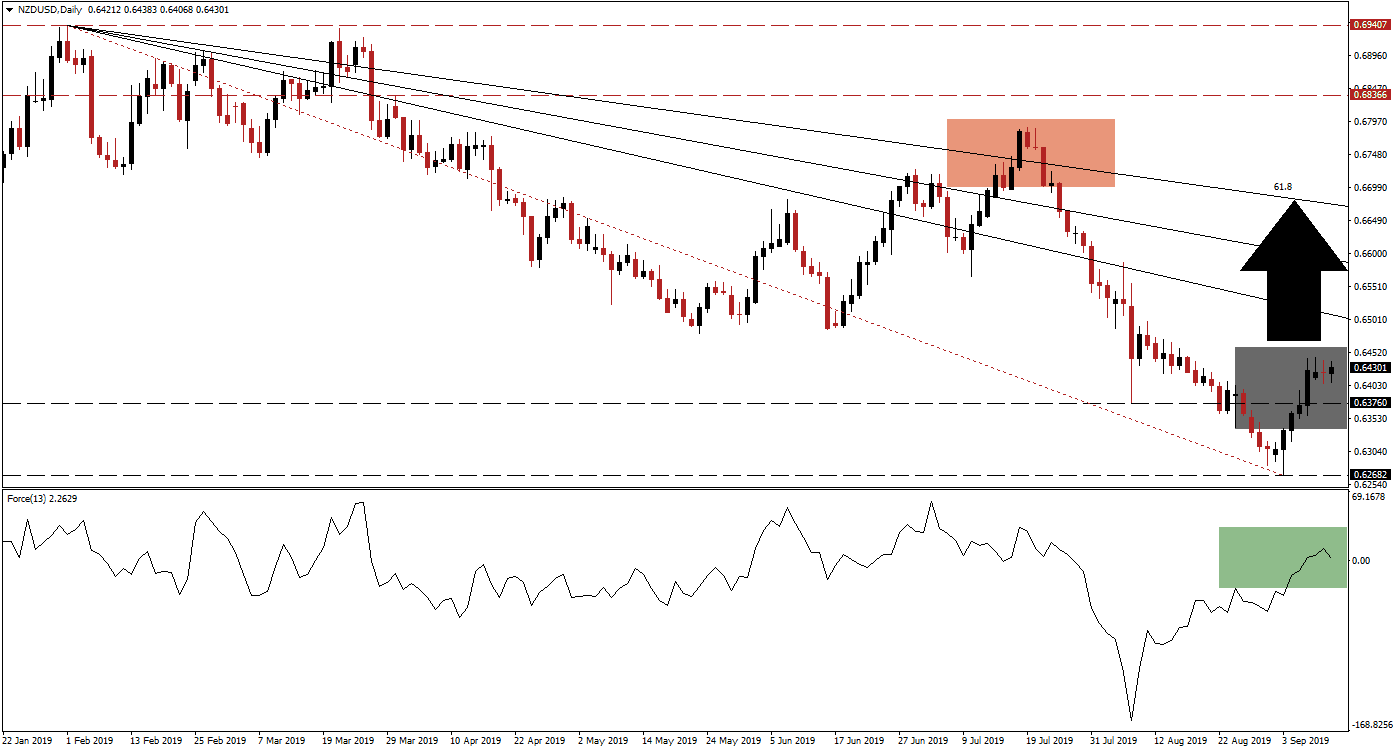The NZDUSD just completed a breakout above its support zone which is marked by the grey rectangle in the chart. Price action accelerated to the upside from its intra-day low of 0.62682 and bullish pressure expanded which resulted in the breakout, but this currency pair has now stalled. A pause after a breakout event is normal and price action may retrace part of its advance before extending its advance. Preceding the breakout was a sell-off in the NZDUSD following a brief spike above its 61.8 Fibonacci Retracement Fan Resistance Level, marked in the red rectangle. Economic data released out of New Zealand this morning showed an increase in visitor arrivals, a positive for its tourism industry as the country is seeking to diversify its economy away from commodity exports.
What is the Fibonacci Retracement Fan?
The Fibonacci Retracement Fan is a different visualization of the Fibonacci retracement sequence which outlines important support and resistance levels in technical analysis. Those levels warrant a closer look and offer entry and exit levels for trades together with other aspects of the analysis.
The Force Index, a next generation technical indicator, has contracted together with price action as the NZDUSD entered its correction from above its 61.8 Fibonacci Retracement Fan Resistance Level down into its support area. Before this currency pair recorded its most recent intra-day low of 0.62682, the Force Index started to gradually recover which formed a positive divergence. A positive divergence is formed when price action continues to decline as the underlying technical indicator advances, this creates a strong bullish trading signal. Following the breakout above its support zone, the NZDUSD will now face its next resistance level at the 38.2 Fibonacci Retracement Fan Resistance Level.
What is the Force Index?
The force index is considered a next generation technical indicator. As the name suggests, it measures the force behind a move. In other words, forex traders will get a better idea behind the strength of bullish or bearish pressures which are driving price action. The indicator consist of three components (directional change of the price, the degree of the change and the trading volume). This creates an oscillator which in conjunction with other aspects of technical analysis provides a good indicator for potential changes in the direction of price action. It subtracts the previous day closing price from today’s closing price and multiplies it by the volume. Strong moves are supported by volume and create the most accurate trading signals.
As the breakout developed, the Force Index has pushed into positive territory marked by the green triangle in the chart. This confirms that bears are no longer in control of price action and that bulls have taken over. Price action may contract back down into its support zone which is expected to drag the Force Index back into negative territory, but the uptrend is expected to remain intact. Given the previous sell-off, a short-covering rally is likely to follow which will further push the NZDUSD to the upside. As long as this currency pair can remain above its support zone, bullish momentum should further expand.
What is a Support Zone?
A support zone is a price range where bearish momentum is receding and bullish momentum is advancing. They can identify areas where price action has a chance to reverse to the upside and a support zone offers a more reliable technical snapshot than a single price point such as an intra-day low.
Given the rise in bullish momentum, forex traders should expect another breakout in the NZDUSD above its 38.2 Fibonacci Retracement Fan Resistance Level. While the long-term downtrend will remain intact until this currency pair can advance above the 61.8 Fibonacci Retracement Fan Resistance Level, the technical scenario is slowly turning from bearish into bullish, led by the advance in the Force Index which followed the breakout above its support zone. An extension of the breakout remains the dominant scenario and the upside potential outweighs the downside risk.
What is a Breakout?
A breakout occurs if price action moves above a support or resistance zone. A breakout above a support zone could signal a short-term move, such as a short-covering rally which occurs when forex traders exit short positions and realize trading profits, or a long-term move such as the start of a trend reversal from bearish to bullish. A breakout above a resistance zone signals strong bullish momentum and an extension of the existing uptrend.
NZDUSD Technical Trading Set-Up - Breakout Extension
Long Entry @ 0.64250
Take Profit @ 0.66800
Stop Loss @ 0.63450
Upside Potential: 255 pips
Downside Risk: 80 pips
Risk/Reward Ratio: 3.19
A price action reversal in the NZDUSD will occur if the price cannot maintain its position above the support zone and if this currency pair completes a breakdown below 0.63760. This level represents the top range of its support zone and if the breakdown is confirmed by a contraction in the Force Index below its current uptrend, more downside should be expected which could lead to a breakdown below its support zone.
What is a Breakdown?
A breakdown is the opposite of a breakout and occurs when price action moves below a support or resistance zone. A breakdown below a resistance zone could suggest a short-term move such as profit taking by forex traders or a long-term move such as a trend reversal from bullish to bearish. A breakdown below a support zone indicates a strong bearish trend and the extension of the downtrend.
NZDUSD Technical Trading Set-Up - Breakdown Scenario
Short Entry @ 0.63100
Take Profit @ 0.61700
Stop Loss @ 0.63600
Downside Potential: 140 pips
Upside Risk: 50 pips
Risk/Reward Ratio: 2.80

